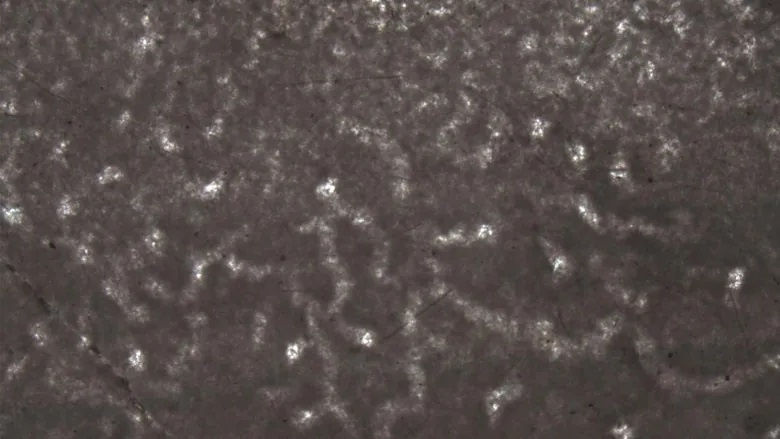According to the most widely accepted theories, evolutionary biologists assert that life on Earth began roughly 4 billion years ago, beginning with single-celled bacteria and gradually giving way to more complex organisms. According to this same evolutionary timetable, the first complex organisms emerged during the Neoproterozoic era (ca. 800 million years ago), which took the form of fungi, algae, cyanobacteria, and sponges.
However, due to recent findings made in the Arctic Circle, it appears that sponges may have existed in Earth’s oceans hundreds of millions of years earlier than we thought! These findings were made by Prof. Elizabeth Turner of Laurentian University, who unearthed what could be the fossilized remains of sponges that are 890 million years old. If confirmed, these samples would predate the oldest fossilized sponges by around 350 million years.
Elizabeth Turner is a Professor of Carbonate Sedimentology and Invertebrate Paleontology with the Harquail School of Earth Sciences, Laurentian University, in Sudbury, Ontario. She is also a field-based geologist with 30 years of experience in Canada’s Northwest Territories, who specializes in the dynamics of carbonate and shale basins dating to the Proterozoic and Paleozoic Eras. The study that describes her research appeared in the July 28th issue of the journal Nature.

To summarize, sponges are simple lifeforms and one of the earliest forms of multi-celled life. Genetic evidence from modern sponges indicated that the first sponges emerged during the Neoproterozoic Era (ca. 1,000 to 541 million years ago), but fossilized remains from this period have been lacking. Turner discovered these fossils while doing fieldwork in the Mackenzie Mountain range in Canada’s Northwest Territories as part of her Ph.D.
While this region, which borders the neighboring territory of Yukon, is part of the Arctic Circle today, it was located in a shallow inland sea in the middle of the supercontinent of Rodinia 890 million years ago – which was much closer to the equator. Turner found these fossilized remains while exploring limestone reef pockets and crevices that form in the presence of photosynthetic microbes known as cyanobacteria (aka. stromatolites).
These fossilized remains were worm-like in appearance and likely formed in the presence of calcium-carbonate-depositing bacteria, as indicated by the networks of tube-shaped structures and the presence of calcite crystals in and around them. These structures closely resemble the fibrous skeletons that have been observed with the modern horny sponge, as well as structures in carbonate rocks that have been attributed to the decay of these animals.
“They are truly identical to the ones that I had in my much older rocks,” said Turner in a recent interview with the CBC. “There weren’t any other truly viable interpretations of the material.” The limestone deposits where Turner found them are also similar to the environments where sponges live today. Prof. Turner theorizes that the structures could be the fossilized remains of horny sponges that lived among calcium carbonate reefs 890 million years ago.

For decades, Turner puzzled over these samples and periodically returned to the Mackenzie Mountains to collect more samples. Then, between 2014 and 2021, researchers in Germany, and the US and Korea published research showing how similar fossils could have formed from horny sponges. This led Turner to conclude that the worm-like fossils may not have formed in the presence of microbes but were the result of sponges that existed 890 million years ago.
These results suggest that the evolution of early animals could have occurred independently of the “Great Oxygenation Event,” which began about 2.4 to 2 billion years ago when photosynthesis metabolized atmospheric carbon dioxide and produced molecular oxygen. For the next billion years, much of this oxygen was absorbed by the oceans and Earth’s crust, but by ca. 800 million years ago, oxygen levels are thought to have reached the point where they could support animal life.
If these structures should prove to be the fossilized remains of ancient sponges, it could mean that the evolution of early animals occurred independently of this oxygenation event. In addition, the reef pockets and crevices where they were found were too dark for photosynthetic cyanobacteria to live in, so there was not likely to be competition between the sponges and other microbes.
However, they still could have been in close enough proximity that the sponges would have been able to capture some oxygen produced by the cyanobacteria (which was in short supply at the time). It would also mean that early animal life survived severe ice ages that occurred between 720 and 635 million years ago – during the Cryogenian Era. All previously discovered samples date to periods that came after this geological period.

This includes the 574-million-year-old fossils discovered in the Mistaken Point Ecological Reserve in Newfoundland and the leaf-like marine creature known as Dickinsonia, which is about 558 million years old. Since its publication, Turner’s study has been peer-reviewed, and multiple scientists have publicly voiced support for her findings – which is unusual since the peer review process is usually anonymous.
Other researchers remain skeptical, like Jonathan Antcliffe, a paleontologist at the University of Lausanne (UNIL) in Switzerland who has disputed previous “oldest sponge” fossil claims. There’s also Qing Tang, a postdoctoral researcher from the University of Hong Kong, who compared these findings to fossils dated to 635 million and 538 million years ago. Here too, these fossils were thought to be the remains of sponges but were later found to be created by microbes. As Qing told the CBC:
“This discovery is overall very interesting. It will be a big step towards a better understanding of early animal evolution if the keratose sponge interpretation is eventually confirmed, particularly given its age… However, as is denoted in the title, these structures are best called possible sponge fossils due to relatively few characters preserved.”
Clearly, more testing will be needed to verify Turner’s conclusions, and more samples will likely need to be obtained from the region for the sake of comparison. As always, the task of reconstructing the history of Earth and biological evolution is an arduous one. But with every new discovery, the mysteries of how life emerged and evolved on our planet are slowly dispelled. This ongoing pursuit also aids in our search for life elsewhere in the Solar System and (ultimately) the Universe.


“…beginning with single-celled bacteria and gradually giving way to more complex organisms.”
They gave way? I don’t think so. Bacteria are the dominant life forms on the planet. Don’t buy your own hype. You personally are carrying around about 100 trillion bacteria right now. Your roles in this relationship are transportation, environmental controls and nutrient supply. And if all goes to plan, we will soon be carrying bacteria in their gazillions to other planets, and there sustaining them until they have learned to flourish in those new environments, perhaps the next great evolutionary leap: life on other planets. Take comfort in the knowledge that your life has a purpose.
Evolution is random, so “leaps” are post facto rare events – there is no goal, no “purpose” in nature. [“Purpose” is something individuals gave to, and often do, assign to themselves according to their predilections. It is culture, not nature.]
But I guess that – “purpose” – is actually your flourish of writing, same as the article’s “giving way”.